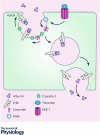Novel mechanisms regulating endothelial barrier function in the pulmonary microcirculation
- PMID: 30015354
- PMCID: PMC6375872
- DOI: 10.1113/JP276245
Novel mechanisms regulating endothelial barrier function in the pulmonary microcirculation
Abstract
The pulmonary epithelial and vascular endothelial cell layers provide two sequential physical and immunological barriers that together form a semi-permeable interface and prevent alveolar and interstitial oedema formation. In this review, we focus specifically on the continuous endothelium of the pulmonary microvascular bed that warrants strict control of the exchange of gases, fluid, solutes and circulating cells between the plasma and the interstitial space. The present review provides an overview of emerging molecular mechanisms that permit constant transcellular exchange between the vascular and interstitial compartment, and cause, prevent or reverse lung endothelial barrier failure under experimental conditions, yet with a clinical perspective. Based on recent findings and at times seemingly conflicting results we discuss emerging paradigms of permeability regulation by altered ion transport as well as shifts in the homeostasis of sphingolipids, angiopoietins and prostaglandins.
Keywords: Sphingosine-1-phosphate; TRP channels; ceramide; cystic fibrosis transmembrane conductance regulator; endothelial barrier; prostaglandin; pulmonary microvessels; transcytosis.
© 2018 The Authors. The Journal of Physiology © 2018 The Physiological Society.
Figures




References
-
- Alexander JS, Patton WF, Christman BW, Cuiper LL & Haselton FR (1998). Platelet‐derived lysophosphatidic acid decreases endothelial permeability in vitro. Am J Physiol 274, H115–H122. - PubMed
-
- Andrade L, Rodrigues AC Jr, Sanches TR, Souza RB & Seguro AC (2007). Leptospirosis leads to dysregulation of sodium transporters in the kidney and lung. Am J Physiol Renal Physiol 292, F586–F592. - PubMed
Publication types
MeSH terms
LinkOut - more resources
Full Text Sources
Other Literature Sources

